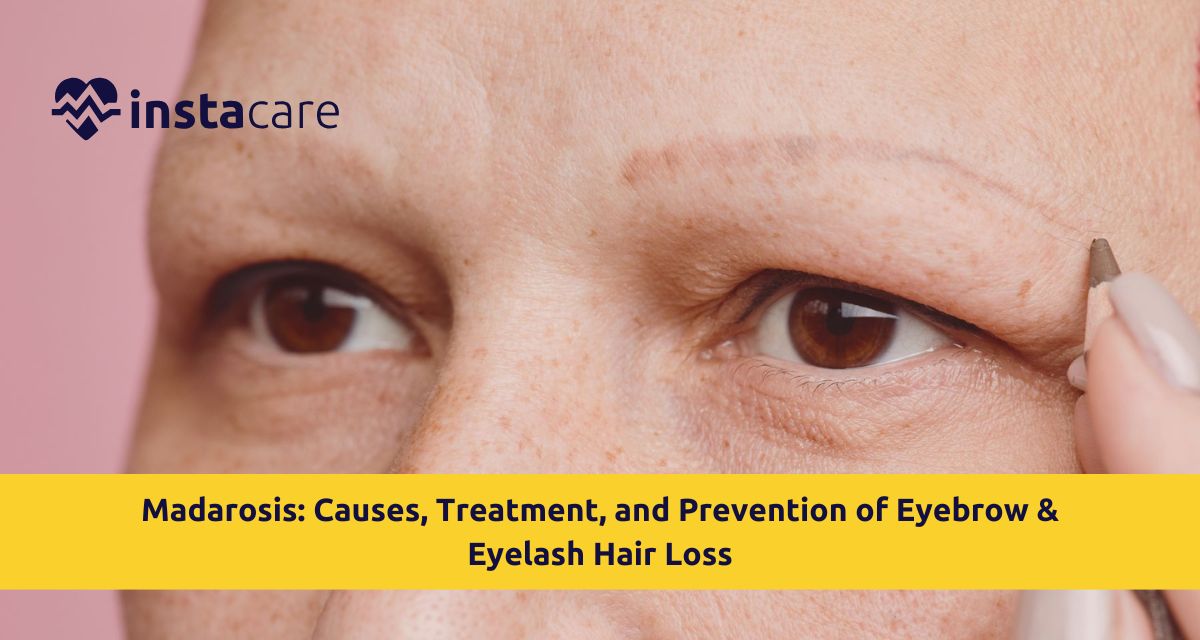Some folks ignore sparse eyebrows or eyelashes till changes are clear. Yet spotting issues early, along with good care, may boost chances for regrowth. Here's a look at Madarosis: causes, available treatments, while offering simple habits to support brow and lash wellness.
What is Madarosis?
Madarosis is when eyebrow hairs fall out, sometimes called superciliary type, or lashes stop growing back, known as cilia form. Follicle harm can come from swelling, trauma, shifts in hormones, or health issues. How long it lasts, short-term or lifelong, depends on what's causing it.
Two primary kinds exist:
- Non-scarring madarosis means losing hair but keeping healthy follicles, so recovery can happen if treatment starts early with proper attention.
- Scarring madarosis harms hair roots for good, so new growth often doesn't occur, or simply can't.
Spotting the kind quickly makes it easier to choose a suitable approach, since knowing what it is guides better decisions.
Common Causes of Eyebrow & Eyelash Hair Loss
Madarosis may arise due to different reasons. Although certain triggers resolve fast, allowing healing, some require ongoing care.
1. Nutritional Deficiencies
A lack of iron or zinc may damage hair follicles, leading to thinning brows and lashes. When biotin is insufficient, particularly if omega-3s are also low, the root structure weakens gradually. Poor diet, missing essential vitamins, often causes increased shedding over time. Each deficiency influences new growth in a unique way.
2. Hormonal Imbalance
Thyroid issues or PCOS might interfere with hair development, pregnancy occasionally plays a role. Menopause brings shifts; meanwhile, stress-triggered hormones also have an effect.
3. Skin Conditions
Eczema or psoriasis can lead to swollen eyelids, then loss of lashes. Fungal skin issues or inflammation might result in reddish tint, along with thinning brows.
4. Autoimmune Diseases
Conditions such as alopecia or lupus make the body's defense system target hair roots, resulting in fast shedding. In some cases, there's mild thinning; in others, full bare spots show up quickly. Since these illnesses treat healthy cells as threats, treatment focuses on calming immunity rather than just encouraging new growth.
5. Over-Plucking & Physical Trauma
Frequent threading, or occasionally waxing, may harm follicles, especially if you often rub your eyes.
6. Medications & Medical Treatments
Chemotherapy sometimes leads to short-term madarosis; likewise, steroid use could cause it. On the flip side, retinoids rarely have this impact. Then again, certain antidepressants might play a role too.
7. Infections
Bacterial or viral issues affecting the eyelid, such as blepharitis, may lead to thinner lashes.
8. Stress and Anxiety
Stress affects hair development, sometimes triggering repeated tugging, known as trichotillomania. Emotional strain can disrupt follicle function, leading over time to damaging behaviors through gradual buildup.
9. Allergic Reactions
Cosmetics or glue from lash extensions can bother the scalp edge; likewise, intense skincare products may lead to discomfort. Although some people experience no issues with cosmetics, others see redness following specific lotions.
Finding the real reason guides your solution, because clear insight improves choices.
Symptoms & Diagnosis of Madarosis
Signs might show as sparse eyebrows or missing eyelashes, sometimes only one side, other times affecting both sides.
Common Symptoms
- Thinning eyebrows, over time or quickly, or eyelashes growing less dense
- Patches without hair
- Redness might appear near hair roots, often along with itchiness; peeling can occur too
- Fragile or thin hair fibers
- Eyelid discomfort or dryness in the eye
If symptoms continue past several weeks, consider seeing a doctor, because early appointments can spot hidden problems.
Diagnosis
A medical professional, commonly one focused on skin or vision, might take steps like these:
- Physical exam: Assessing how much hair is lost, while also looking at the way it's distributed.
- Medical background: Check daily habits, medicines taken, eating patterns, also consider hereditary factors.
- Blood tests may detect low vitamins; additionally, they help spot hormone problems through lab analysis.
- Skin scrapings or a biopsy might be considered if there's suspicion of infection or immune issues, but not until initial assessments are done. Even when clues suggest a direction, physicians hold off until they've looked over preliminary findings. Should symptoms continue, additional tissue exams may follow instead of rushing in. Rarely needed upfront, these approaches can reveal what basic tests miss.
A precise diagnosis means therapy targets the real source rather than merely addressing signs.
Read More: How To Apply Eyelash Serum - Step By Step Guide For You
Treatment Options for Madarosis
Treatment varies based on health, habits, or appearance. Common approaches include these choices:
1. Medication
- Topical solutions like minoxidil, bimatoprost, or peptide blends may encourage fresh hair growth, though results vary depending on usage patterns. Improvement occurs in certain cases; however, personal effectiveness relies largely on regular use and technique.
- Oral therapies use supplements like iron; when tests show low levels, vitamin D may also be added. Sometimes, depending on lab outcomes, zinc or biotin gets included instead.
- Steroids or anti-inflammatory creams help when the immune system attacks the skin. As a result, internal swelling may decrease. If irritation happens due to incorrect targeting, these treatments calm the area.
2. Treating Underlying Conditions
Treating thyroid problems, PCOS, infections, or allergies might prevent madarosis from progressing, depending on the cause. While some cases improve with care, others need time plus consistent treatment. Each situation varies; results differ even when similar methods are used.
3. Eyelid Hygiene
With blepharitis, warm compresses followed by gentle lid cleaning may support regrowth of eyelashes, topical treatments can also be beneficial.
4. PRP Therapy (Platelet Rich Plasma)
Your body's plasma gets used on the brows to help hair grow. It works better when the skin there isn't scarred.
5. Low-Level Laser Therapy
Boosts circulation, this supports hair roots deeply.
6. Hair Transplant (for Scarring Madarosis)
In serious or ongoing situations, fixing eyebrows or lashes might require a small procedure, using precise tools to move hair roots carefully; alternatively, tiny techniques can shift follicles gently.
7. Cosmetic Options
As you wait for your hair to grow back naturally:
- Brow pencils or powders
- Eyelash extensions – permitted only when safety is confirmed
- Dermatologist-approved serums
Early support increases the likelihood of strong hair coming back, proper methods matter. Quick action when symptoms appear improves outcomes, especially if started promptly.
Prevention & Care Tips for Madarosis
Caring for your skin influences how strong your brows stay. What you eat affects hair health over time. Daily routines shape whether lashes thin out or not.
1. Maintain a Balanced Diet
Select meals high in protein together with iron; include sources of good fats while adding foods packed with vitamins to help maintain robust hair roots.
2. Avoid Over-Plucking
Frequent waxing damages hair follicles, so scale back, try gentler methods instead. Since constant removal stresses roots, go for softer alternatives when you can.
3. Choose Gentle Skincare
Avoid strong cleansers, also skip powerful acids near the eyes, since low-quality makeup can cause irritation too.
4. Reduce Stress
Try breath control, or focus on now, to help regulate bodily chemistry. On the flip side, yoga might support natural hormone stability.
5. Maintain Eyelid Hygiene
Cleaning usually prevents eye infections or irritation. Sometimes it reduces swelling near the eyes.
6. Avoid Constant Rubbing
Rubbing your eyes causes irritation; eventually, it may damage hair follicles as well.
7. Remove Makeup Properly
Always remove mascara before bed. Use gentle face wash, this helps prevent blocked pores.
8. Treat Skin Conditions Early
Tackle eczema, allergies, or skin swelling early, before damage reaches hair follicles.
These routines shield eyebrows and eyelashes, lowering risks of becoming sparse. Yet, they support natural regrowth by preventing ongoing damage. Still, keeping up consistency matters most to limit breakage or shedding. Over weeks, small changes may lead to improvement.
When to See a Doctor for Madarosis
You ought to see a physician if:
- The hair falls fast
- You see areas without hair here or there
- You're dealing with redness, swelling, or maybe intense itching instead
- Hair won't regrow, despite waiting many months
- You realize there's a chance it's your thyroid, perhaps even something tied to immunity
- Problems become worse slowly over time
Timely care stops lasting hair root harm, meanwhile boosting recovery odds.
Conclusion
Madarosis affects eyebrow and eyelash appearance, but often gets better with careful care. When triggered by hormone shifts, poor nutrition, skin issues, or mild pressure, recovery usually follows accurate identification together with quick action. Healing strategies paired with daily adjustments as well as consistent protection support natural regrowth.
If you notice steady hair loss or sparse spots near your eyes, seeing a skin specialist soon makes a difference. Through proper treatment combined with daily routines, eyebrows plus eyelashes could grow back thicker, and handle stress better over time.
Book an appointment with the best Dermatologist in Lahore, Karachi, Islamabad, and other major cities through InstaCare. You can also call 0317-1777509 to connect with a verified doctor. Use the button below to book now.

